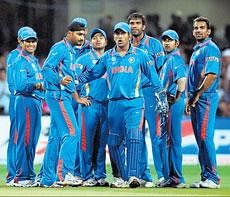

It was a classic case of getting out of jail, with generous help from an opposition that simply didn’t believe, it seemed, as if it had the wherewithal to get over the line.
Saying that, the unexpected tie, and one point gained, from Sunday’s match against England should do little to assuage the concerns of the Indian think-tank. Coming into the World Cup with several question marks over their bowling, India have failed to answer any of those queries with conviction.
In reasonably helpful conditions, India’s bowling can be a handful, but on flat pitches like the belter at the Chinnaswamy stadium, it can come under serious pressure. When Andrew Strauss, Kevin Pietersen and Ian Bell were toying with the bowling, Mahendra Singh Dhoni just ran out of ideas. His cause wasn’t helped by one of the poorest collective efforts in recent times with the ball, even in batsman-friendly conditions; India must find a way around their bowling woes if they are to justify favouritism and not put any more pressure than already is on their high-voltage batting line-up.
The next ten days offer India a fantastic opportunity to not just re-assess their options, but also for a paradigm shift in thinking. It’s increasingly becoming apparent that should they bat first, India need the cushion of close to 350 runs against teams with reasonable batting might. One singular collapse, especially in a knockout game, could signal the end of the campaign and the shattering of a billion dreams, and even for a line-up of staggering talent, that is far from the ideal position to be in.
Sunday reiterated, if proof was needed, that India perforce require another specialist bowling option. Yes, their march to the 2003 World Cup final was built around seven batsmen. Things were different then, because there was reasonable assistance for the quicks from the South African pitches, and there were plenty of part-time options that Sourav Ganguly could fall back on.
India have traditionally been reluctant to play five full bowlers, relying on four specialists and their undisputed batting might to carry the day. The time has come for a serious rethink, especially with Ireland and the Netherlands their next two opponents. These are games India will be expected to win 99 times out of 100, so if there is a time to experiment, it is now.
Sunday showed up the dangers of going in with just two quicks. Perhaps, Zaheer Khan had a rare bad day in office during his first spell, perhaps both he and Munaf Patel couldn’t adjust to the ferocity with which Strauss and Pietersen came at them. Other teams would have taken note of the aggressive English approach and will fancy their own chances; Dhoni will have to consider the enormous risks that go with leaving out the third seamer and bite the bullet. At least for the next two games, it won’t be the worst option to play the additional bowler at the expense of a batsman, if only to see how things pan out.
One of the justifications the Indian skipper had given for Piyush Chawla’s international one-day career being resurrected after more than two years was that he was a quasi all-rounder who could bat at seven, and wheel down ten overs of leg-spin. Dhoni had hinted at a straight fight between Chawla and Yusuf Pathan for that slot; that option must be exercised now, especially given the form of the Indian top-order, because while Pathan’s peerless explosiveness is a massive ace up the sleeve, he can also become somewhat redundant, as evidenced by the first two matches.
His place could then be occupied by Ashish Nehra, when fully fit, or S Sreesanth, as unpredictable as they come but whose unpredictability can at times be his greatest strength. As he has shown time and again, Sreesanth has this wonderful knack of producing genuine wicket-taking deliveries, though when he has an off-day, there simply is nowhere to hide. He could do with being handled slightly better, but he can also help himself by cutting out the antics and concentrating on his cricket. Nehra is a more proven performer, but unless he can shed his propensity to pick up unrelated injuries, it will be difficult to back him with any great confidence.
Bangladesh’s spirited chase of 370 in Dhaka exposed the fragility of the Indian bowling, and Sunday has done little to change that notion. India must react before it is too late, otherwise their World Cup drought will comfortably extend beyond 28 years.